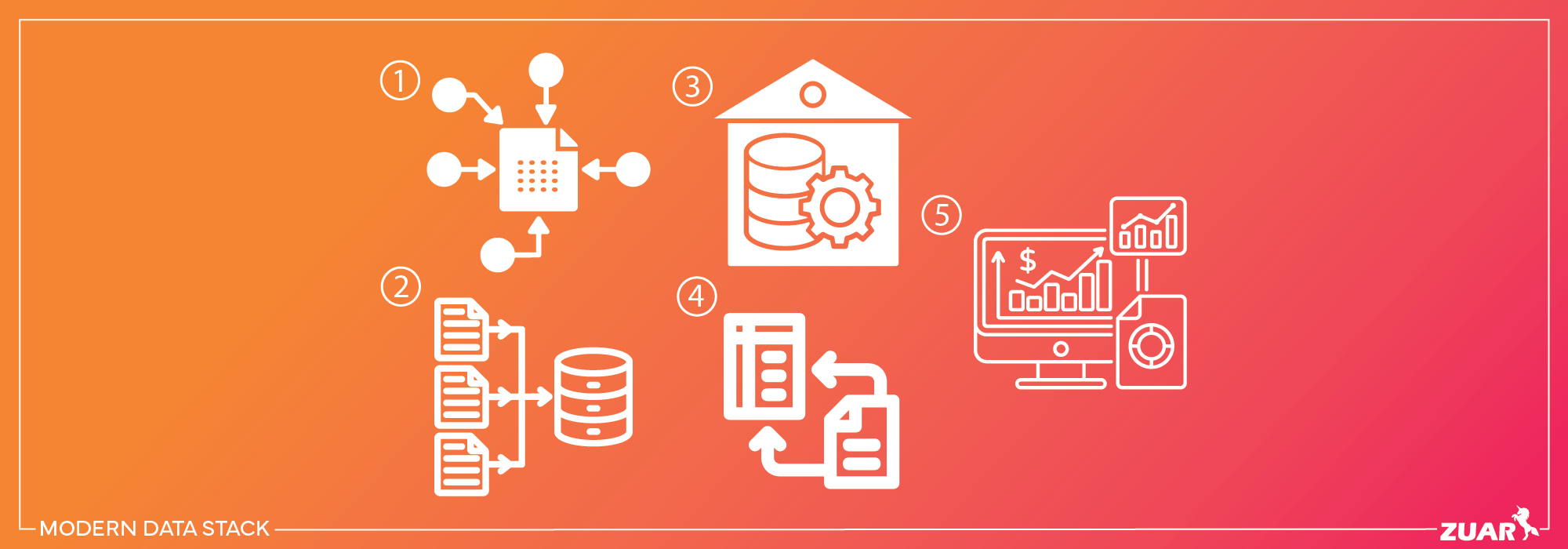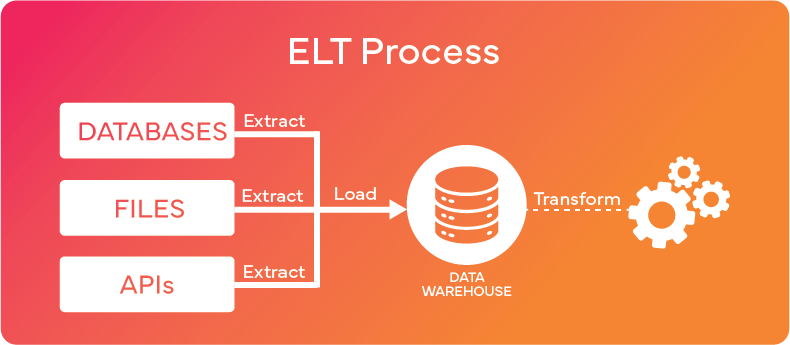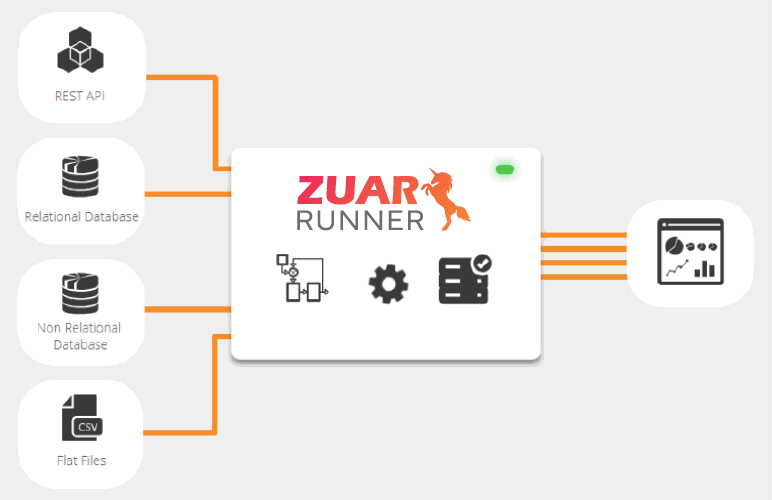The Modern Data Stack: What it Looks Like & What Will Come Next
Learn what the modern data stack is, the components that make it up, the role of data integration and transformation, how to build one, and more!

Overview
In today’s data-driven world, having a modern data stack is no longer just an advantage but a necessity for businesses to stay competitive.
With the ever-growing volume, variety, and velocity of data, traditional data stacks struggle to keep up. In response, a new generation of cloud-based tools and technologies has emerged, designed to help organizations manage, process, and analyze their data more efficiently.
Let’s dive into the world of the modern data stack and discover how it can enable data-driven decision-making and unlock valuable insights for your business.

Understanding the Modern Data Stack
A modern data stack leverages a collection of cloud-based tools and technologies designed to enhance the management, processing, and data analysis, leading to more data-driven decisions.
This innovative approach presents substantial benefits over traditional data stacks, including:
- Improved efficiency in data management, processing, and analysis
- Decreased cost of data analysis
- Increased accessibility to modern data stack technologies for businesses of all sizes
The Need for a Modern Data Stack
Traditional data stacks, often likened to a tangled mess of Christmas lights, are increasingly struggling to handle the demands of today’s data-heavy world. These legacy data stack systems are typically hosted on-premises, making them less flexible and more difficult to scale than their modern, cloud-based counterparts.
Consequently, organizations are gravitating towards modern data stacks to bypass the constraints of conventional data stacks and fully exploit their data assets. The adoption of cloud and SaaS-based tools in modern data stacks significantly reduces user workload, shifting their focus from technology to business outcomes.
Furthermore, these advanced data stacks enhance cost efficiency as the payment model is based on usage, relieving users from acquiring underlying resources individually.
Furthermore, the modularity of modern data stacks allows for the inclusion of additional components, avoiding vendor lock-in and providing businesses with the flexibility they need to adapt to evolving data requirements.
Key Components of a Modern Data Stack
The main components of a modern data stack typically include:
- Data Sources: Where data originates, such as databases, applications, and external APIs.
- Data Integration: Tools and processes for collecting, combining, and transforming data from various sources.
- Data Warehousing: A central repository for storing and managing structured data, often in a cloud-based solution.
- Data Transformation: The process of cleaning, enriching, and structuring raw data for analysis.
- Data Visualization and Business Intelligence: Tools for creating interactive dashboards and reports for data analysis and decision-making.
These components form the core of a modern data stack and provide the foundation for data management and analytics within an organization.

Cloud-Based Data Warehouses: The Foundation
As the cornerstone of the modern data stack, cloud-based data warehouses offer:
- Scalable, versatile, and cost-efficient storage and analytics capabilities
- A single platform for data engineers and analysts to leverage data for analysis and value generation
Popular Cloud Data Warehouse Solutions
Several popular cloud data warehouse solutions are available to meet the diverse needs of organizations, including:
- Amazon Redshift (AWS): Amazon Redshift is a fully managed data warehousing service that offers high performance and scalability. It's known for its ease of use and integration with other AWS services, making it a popular choice for organizations using the AWS ecosystem.
- Google BigQuery (Google Cloud): Google BigQuery is a serverless, highly scalable data warehouse that allows users to analyze large datasets using SQL queries. It's known for its speed and flexibility, as well as seamless integration with other Google Cloud services.
- Snowflake (Multi-cloud): Snowflake is a cloud-native data warehousing platform that offers features like automatic scaling, data sharing, and support for multiple cloud providers (AWS, Azure, Google Cloud). It's known for its simplicity and ease of use, making it a favorite among organizations looking for a multi-cloud or hybrid cloud solution.
These data warehouse solutions are widely used for their performance, scalability, and integration capabilities, making them popular choices for modern data analytics and reporting.
Choosing the Right Data Warehouse for Your Business
Selecting the right data warehouse for your business involves considering several factors, including the size and complexity of your data, the number of data sources to be integrated, and the specific analytics requirements your organization faces.
Additionally, it’s essential to ensure that the chosen platform is compatible with your company’s data stack and meets its data privacy, security, and compliance needs.

Data Integration and Transformation: Connecting the Dots
Data integration and transformation are crucial components of the modern data stack, responsible for connecting various data sources and preparing the data for analysis.
Data integration involves transporting data from multiple distinct internal and external sources and consolidating it into a single location to gain a unified view of the collected data.
Data integration can be divided into two distinct categories: batch-based and real-time. Each type has unique characteristics and benefits.
ETL vs. ELT Approaches
The distinction between ETL and ELT approaches lies in the order of data processing. ETL emphasizes transforming data prior to loading it into the data warehouse, while ELT emphasizes loading data into the data warehouse before transforming it.
By prioritizing data loading, the ELT approach enables faster and more efficient data processing, allowing organizations to quickly analyze their data and make data-driven decisions.
In today’s modern data stack, ELT is the preferred approach, as it better aligns with the capabilities of cloud-based data warehouses and the growing volume and variety of data sources.
By leveraging the power of modern data integration and transformation tools, organizations can streamline their data pipelines and ensure that their data is ready for analysis when it’s needed most.

Tools for Data Integration and Transformation
Several tools are available to support the ELT approach, including:
- Zuar Runner
- dbt
- Qlik Compose
- Dataform
These data transformation tools are designed to help organizations automate their data pipeline, facilitate data management, and generate regular reports to measure key performance indicators.
By using tools like these, organizations can ensure that their data is properly integrated and transformed, making it easier for data professionals to analyze data and uncover valuable insights.
As the only complete, end-to-end solution on the above list, we recommend Zuar Runner for your data integration and transformation. Runner is able to automate the collection of data from hundreds of potential sources into a single destination.
Learn how Zuar Runner fits into the modern data stack and can bridge the gap between modern and legacy systems:
Collect, transform, model, warehouse, report, monitor, and distribute: it's all managed by Zuar Runner. Learn more...

In addition to these tools, solutions such as Apache Kafka and Snowpipe by Snowflake are effective for streaming data directly into the cloud warehouse for real-time data processing.
By incorporating these tools and technologies into your modern data stack, you can ensure that your data is always up-to-date and ready for analysis, allowing your organization to make data-driven decisions and stay ahead of the competition.

Business Intelligence and Visualization: Unleashing Insights
Business intelligence and visualization tools play a vital role in the modern data stack, helping organizations unlock insights from their data and enabling data-driven decision-making.
These tools render data visually, making it easier for users to explore, analyze, and understand the information.
Selecting the right BI tool for your organization is critical, as it can help you uncover hidden patterns, trends, and relationships in your data. With a wide range of BI and visualization tools available, it’s essential to choose the one that best aligns with your organization’s needs, data stack, and overall business objectives.
Popular BI and Visualization Tools
Several popular BI and visualization tools are available to cater to different user needs and preferences, including Tableau, Looker, and Power BI.
These tools offer a comprehensive range of features and capabilities, such as data visualization, data exploration, data analysis, and reporting.
The selection of the appropriate BI tool for your organization hinges on the evaluation of several factors, including:
- The tool’s user-friendliness
- Flexibility in visualization
- The capabilities of end-user self-service
- Compatibility with your organization’s existing data ecosystem and infrastructure
- The specific data challenges and objectives your organization faces
- The tool's embedded analytics capabilities
However, having well-designed data visualizations is useless if employees can't access them. Providing your users with easy access to your enterprise-wide analytics is crucial to ensure analytics usage, which is why embedded analytics solutions such as Zuar Portal are so valuable.
Check out these examples of data visualization using Zuar Portal:
To create a shortlist of potential BI tools, gather input from stakeholders and conduct a proof of concept or tool evaluation to assess each tool’s scalability and performance in accordance with your organization’s growth and evolving needs.

Data Governance and Security: Safeguarding Your Data Assets
Data governance and security form integral facets of a modern data stack, safeguarding data privacy, ensuring compliance and quality, preventing breaches, and preserving customer trust.
Data Governance Frameworks
Data governance frameworks offer guidelines and best practices for effectively managing data assets, such as data cataloging, lineage, and observability. These frameworks can help organizations ensure data quality, maintain compliance with data privacy regulations, and protect sensitive data from unauthorized access.
A comprehensive data governance framework should involve a multidisciplinary team composed of stakeholders from various organization areas, who will formulate policies and procedures for data management, supervise data usage, and ensure adherence to data standards.
Data Security Measures
Data security measures form an essential component of a modern data stack, helping to safeguard data assets and protect sensitive information from unauthorized access. These measures include encryption, access controls, and monitoring tools.
Encryption is the process of encoding data to ensure that only authorized users can access it, thereby protecting data from unauthorized access and guaranteeing that the data remains unaltered.
Access controls, on the other hand, are security measures implemented to ensure that only authorized users can access data, including authentication methods such as passwords, biometrics, and two-factor authentication.
Monitoring tools are utilized to:
- Detect and alert on any potential suspicious activity or unauthorized access attempts
- Track user activity
- Ensure that data is being used in accordance with company policies.

Building and Maintaining Your Modern Data Stack
The construction and upkeep of a modern data stack involves multiple crucial steps, commencing with the evaluation of your data needs and objectives.
By identifying the specific data challenges and objectives your organization faces, you can guide your choice of tools and technologies and ensure that your data stack is optimized to meet your unique needs.
Additionally, assembling a skilled data team is essential for optimizing and maintaining your modern data stack, as these professionals can help you maximize your data and ensure that your data stack is secure and compliant.
It is also imperative to conduct regular reviews and updates of your data stack to guarantee its alignment with your organization’s needs and its adaptability to evolving business requirements.
By monitoring performance, considering new tools, and fostering a data culture within your organization, you can ensure that your modern data stack remains relevant and effective in the face of evolving data challenges.
Assessing Your Data Needs and Goals
The first step in building and maintaining a modern data stack is to assess your data needs and goals. This involves:
- Identifying the specific data challenges and objectives your organization faces, such as understanding customer behavior, optimizing product usage, or streamlining operations.
- Clearly defining your data needs and goals to guide your choice of tools and technologies.
- Ensuring that your data stack is optimized to meet your unique requirements.
Once you have identified your data needs and goals, you can evaluate the available tools and technologies that can help address these challenges and objectives.
Assembling a Data Team
Assembling a data team is an essential component of building and maintaining a modern data stack.
A skilled data team, composed of data architects, engineers, analysts, and data scientists, can optimize and maintain your data stack, ensuring that it remains secure, compliant, and efficient in meeting your organization’s data needs.
When assembling a data team, it’s important to:
- Identify the roles to be filled
- Evaluate the skills and expertise required for each role
- Recruit the appropriate data professionals
- Facilitate their onboarding and training to ensure they have the necessary knowledge and skills to effectively manage your data stack.
By assembling a strong data team, you can optimize your modern data stack to meet your business requirements and generate valuable insights that drive growth and success.
Regularly Reviewing and Updating Your Data Stack
Regularly reviewing and updating your data stack is crucial to ensuring that it continues to meet your organization’s needs and adapts to changing business requirements. This involves:
- Monitoring performance
- Considering new tools and technologies
- Fostering a data culture within your organization, that encourages collaboration between teams, provides ongoing training and support, and ensures data availability to all relevant stakeholders.
By regularly reviewing and updating your data stack, you can ensure that it remains relevant and effective in the face of evolving data challenges and opportunities.
This proactive approach to data management helps maintain the performance and efficiency of your data stack.

Implementing a Modern Data Stack
A modern data stack is a powerful tool for organizations to manage, process, and analyze data, enabling data-driven decision-making and unlocking valuable insights.
Building such a data stack on your own, though, is a daunting task. That's where Zuar comes in. Not only do we have a team of data experts who are experienced in helping organizations build modern data stacks, we also have the tools to help you do so.
Use Zuar Runner to automate the flow of data from hundreds of potential sources into a single destination for analytics, fully prepped and ready for use. With Zuar Portal, provide customized, secure, global analytics access to any audience. It's a powerful platform with unrivaled flexibility.
For a free consultation on how you can build your own modern data stack, schedule some time with one of our data experts:



